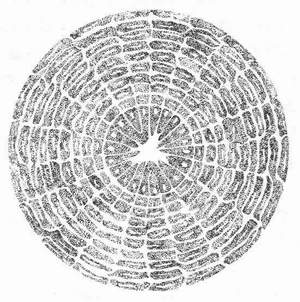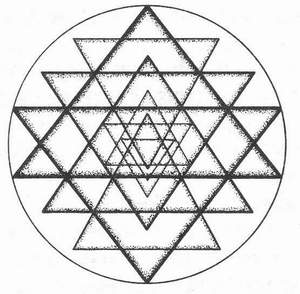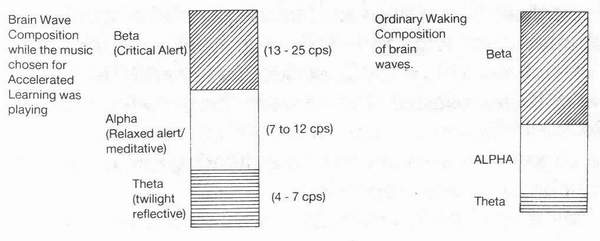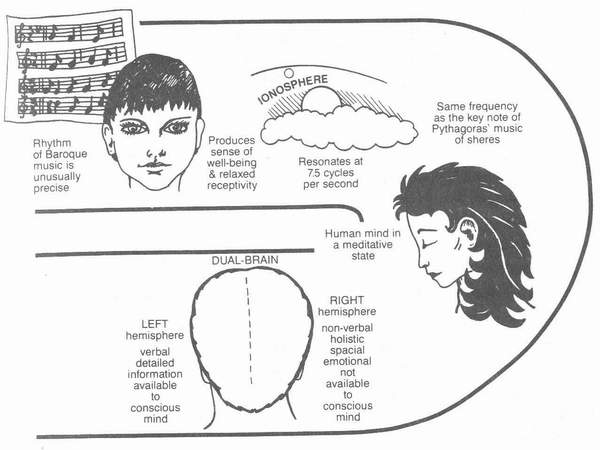
7. What Is The Role Of The Music?
"Music, together with colour, forms the therapy of the future". (Dr. Bernard Jensen)
"Music is the mediator between the life of the senses and the life of the spirit". (Beethoven)
Accelerated Learning is undeniably a breakthrough and one of the elements that most characterises its novelty is the use of music. Yet in many ways this part of the technique was already known to the Ancients. In B.C. Athens, audiences would attend a festival in the Panathenes once every four years. A presenter would chant the entire Iliad to the heartbeat rhythm of a softly playing lyre. From memory. Records show that many of the audience could remember large passages afterwards.
Plato and Aristotle discuss the role of music in "harmonising the soul and body" Plato went further. "The character of a nation's music cannot be altered without changing the customs and institutions of the State".
Confucius echoed the thought:
"The superior man tries to promote music as a means to the perfection of human culture. When such music prevails, and people's minds are led towards ideals and aspirations, we may see the appearance of a great nation".
John Milton specifically discussed the use of music to relax and dispel fatigue in 'Of Education'. The contemporary monasteries regularly used background music to their priests' studies - the same priests who were able to memorise whole books on religious themes.
The effect of music is not confined to philosophers and poets. There can be no human being who has not been touched by the sheer beauty of a ballet movement, or an evocative piece of music. There is no faster way to create or change moods.
The Shamans of Central Russia and the mystics of India use music to induce a planned state of mind and to control pain. In Tibet, Africa and Morocco music is believed to have a magical quality. Bach wrote the Goldberg Variations specifically to induce sleep for the Russian envoy, Count Kayserling.
Science is now corroborating age old intuition. We know that music using certain types of rhythm, does bring about a state of relaxed alertness and physical calm. It is the predominantly alpha brain wave pattern that psychological researchers find is often associated with meditation. Music can do in minutes what weeks of meditative practice strive towards.
Pythagoras believed that musical rhythm could harmonise mental rhythm. He discovered the mathematical proportion of harmonic ratios and intervals and evolved the philosophy of "the music of the spheres". The musical scale, he believed, was related to the movement, and position, of the planets. It is a nice coincidence that we are again discussing the music of the spheres, although those spheres are now the left and right spheres of the brain.
Rhythm
Rhythm is at the heart of the Universe and the Natural world. The ordered rhythm of the stars and planets. The direct influence of the moon. The rhythms of the seasons. These we acknowledge.
The human being is also governed by rhythm. We all have a precise daily rhythm, our circadian cycle. Our hormones rise and faIl in ordered sequence.
That music and rhythm have a direct effect on all living things has been dramatically demonstrated in a series of experiments on plants. Experiments that seem, at first sight, bizarre. They started with tests conducted by Dr. Singh, Head of Botany at the Annamalai University in India. Stimulated by accounts in ancient Tamil literature of peasants using music to stimulate the growth of crops, Dr. Singh played recorded 'lute-like' music to balsam plants.
An identically matched group of plants, receiving identical amounts of water, but no music, acted as a control. Within a month the experimentally `serenaded' plants had 72% more leaves and grew 20% taller.
Further tests sufficiently convinced him to begin a large scale experiment using loudspeakers broadcasting to paddy fields! The resulting harvests were 25% - 60% higher than the regional average.
As these apparently `freaky' experiments gained publicity, researchers in Canada and Kansas began their own controlled experiments. At Ottowa University, Measures and Weinberger managed to duplicate Russian and American research that showed that ultrasonic frequencies had a marked effect on seed germination and growth and even established that different plants reacted best to different frequencies. They suggested in the Canadian Journal of Botany that the accelerated plant growth they had consistently observed was occasioned by the stimulating effect of resonance on the plant cells.
The experiments that are of most interest to us, however, were conducted by a Mrs Rettallack of Denver. Despite the open ridicule of fellow students at the University, she tested the comparative effect of rock music versus classical music on vegetable plants, petunias, zinnias and marigolds.
The plants in the room receiving rock music either grew abnormally tall, with very small leaves, or remained stunted. In every case the plants leaned away from the source of the rock music. Within 2 weeks the flowers died. In the identical control room the plants receiving Baroque compositions, together with the music of Haydn, Brahms and Beethoven, flourished. They outgrew control plants and leaned towards the source of the sound. When she tested Bach and selected classical Indian music, played on the sitar by Ravi Shankar, the plants leaned an unprecedented 60% degrees towards the music, and the nearest ones literally grew to wrap themselves around the speakers.
There is no question about the genuineness of either the experiments or the results and it provides interesting circumstantial evidence for the beneficial effect of Baroque and Classical music on simple living organisms.
But how does it happen?
No one knows for sure. We do know, however, that the Baroque composers were heirs to the belief that there was a sacred geometry about the universe. Nature and the human body was subject to a set of exact ratios and proportions. If these "Golden Means" were reproduced in art, architecture and music, the resulting creations would resonate with a life enhancing force.
We certainly know that one tuning fork, when struck, will cause every other tuning fork in auditory range, to vibrate at the same frequency 'in sympathy'.
As we delve into the micro world of the constituents of the atom, we find that all matter is in a state of vibration. Atoms are harmonic oscillators in which the nuclei are the oscillators themselves and the electrons in their orbits, are the resonators, producing reverberations of the periodic harmonic motions of the nuclei. Individual atoms and molecules have characteristic vibrations. According to physicist Dr. Donald Hatch - "we are finding that the universe is composed not of matter, but of music".
Through the work of Dr. Hans Jenny we can now actually see the wave patterns created by musical notes and their effect on varying kinds of matter.
Dr. Jenny's start point was the work of the eighteenth century German Physicist, Ernest Chladni, who scattered sand on steel discs and observed the changing patterns, produced when various notes were played on a violin. The patterns were created because only certain areas of the disc resonated to the notes, causing the sand to be shifted to the areas that were inert. The Chladni figures are works of art.

Dr. Jenny went much further. Working with liquids, metal filings and powders, he discovered that as pitch ascended the musical scale, the harmonic patterns on the disc also changed but not just to the previous mathematically ordered geometric shapes. The new patterns were organic and mimicked, for example, the hexagonal cells of honeycombs and the vanishing spiral of the primitive nautilus shell.
Stephen Halpern has composed some beautiful music for the specific intention of creating physical and mental health through sound. He writes in his book, 'Tuning the Human Instrument' that, "the forms of snow crystals, the mandala faces of the flowers, actually resonate to the harmony of nature. Crystals, plants and human beings can be seen as music which has taken on form. "
Dr. Hans Jenny working with a 'tonoscope' that transforms sounds uttered into a microphone into their visual representation on a video screen, recorded the sound of Hindi sacred syllable 'OHM'. - the world's most common mantra.

It produced a perfect circle which was filled with concentric triangles and squares. Not only are these symbols found in many of the world's religions but they coincide with the frequency pattern of diminishing harmonics.
Using the same tonoscope, the final chord of Handel's Messiah forms a perfect 5 point star.
We use the phrase that something 'strikes a chord in me'. In London Dr. Manners has actually recorded with a highly sensitive microphone the sound of a human muscle.
The resonance rings true.
Different Music Strikes Different Chords
There is no question that different music has different effects. Playing Mozart, according to French researcher, Mme. Belanger "co-ordinates breathing, cardio-vascular rhythm and brain wave rhythm and leads to positive effects on health. It acts on the unconscious, stimulating receptivity and perception."
In a now famous experiment, subjects were asked to extend their right arm horizontally. Their resistance to downward pressure was measured. The students then relaxed and the experiment was repeated after half an hour but this time rock music (Led Zeppelin) was played. The resistance of every single student was measurably weakened! Classical musical was tested but found to have either a neutral or strengthening effect. You can try it yourself.
Anyone still sceptical about the physical property of music should talk to a professional rock musician. The reason rock, which uses a lot of loud and heavy base guitar, is thought to be sexual, is because it vibrates at a specific frequency which literally vibrates in our loins. Rock seems sexy because it is, physically, sexual.
Mendelssohn once said, "Music cannot be expressed in words, not because it is vague but because it is more precise than words."
If a single note during the Jenny experiments can have such a beautiful (and dramatic) effect, it is hardly surprising that a musical piece that is specifically constructed to be harmonious should have a physically harmonious effect on our minds and bodies.
It appears that the Baroque composers, attempting to create an ideal mathematical form and harmony in their music, managed to produce exactly the right frequency and sound to harmonise the functioning of the brain and produce a state of calm, relaxed alertness. This is why so much emphasis, in the development of Lozanov's technique has been placed on Baroque music - largely composed in the period 1700-1750.
Baroque and classical composers tended to employ a constant theme, and they aimed for symmetry or pattern throughout their work. The main key was established clearly at the beginning of the composition. The first and last movements would be in the tonic key and the slow movement was in a key with a very close relationship to tonic.
It was a primary aim of Baroque composers to use music to create a specific unifying mood and to liberate the mind from earthly concerns. Baroque thereby shares a common aim with certain Indian works, which were also written to create a specifically meditative state.
Baroque music is also characterised by contrasts; contrasts between instruments, bright versus dark sounds.
The contrasts continue between movements - fast / slow / fast; contrasts between the upper (treble) melody and lower, deeper (bass) accompaniment. Nevertheless the overall effect of the contrasts was to produce a single harmonious and unified effect.
The violin, considered to be the expressive instrumental counterpoint to the human voice, featured widely in Baroque music, and the continuous base was often the
harpsichord plus cello or bassoon.
The rhythm of Baroque music is unusually precise. Generally speaking, the music accompanying our own Accelerated Learning language dialogues, features a clearly recognisable melody in the violin or string section, with a steady bass accompaniment to a specific rhythm of 60 beats per minute. We have favoured composers such as Handel, Vivaldi, Bach, Corelli and Telemann.
The effect is to produce a sense of well-being and of relaxed receptivity.
Each concert session is brought to a refreshing and stimulating conclusion with a bright joyful sound - often a flute piece in a major key.
Educational theorist Stephen Cooter monitored his brain wave patterns on an E.C.G. biofeedback machine, while listening to the music recommended for the active concert. He found a 'balanced' and complete brain wave configuration as follows:-

Although the above charts are not exactly to scale, the music had a very measurable effect in increasing the proportion of alpha and theta brainwaves. Studying the effect in detail, Cooter noted, "that largo movements produced a sleepy theta-dominant brain rhythm. When whole classical compositions are used a more balanced and complete brain wave configuration is produced: roughly equal alpha (alert), twilight (relaxed), and beta (critical alert) rhythms are present."
Stephanie Merek, a Lozanov teacher, pointed out that only whole classical compositions are now used in Lozanov classes because they reach and synchronise the whole mind and reproduce the entire "dynamics of inner life . . . a full 24 hour emotional cycle. "
We cannot help noting in passing, that the characteristic shift in the electro magnetic frequency of brain rhythm which this specific Baroque music produces, is towards 7.5 cycles per second. That is Alpha. 7.5 cycles per second is also the exact frequency at which the Ionosphere resonates.
So the Ionosphere, that vacuum layer in the earth's upper atmosphere, which reflects all our radio and T.V. communications, happens to resonate at the precise frequency of the key note of Pythagoras' Music of the Spheres. This 7.5 cps frequency, known as the Schumann Resonance, is also that of the human mind in a meditative state.
Says physicist Robert Beck, contemplating the Schumann Resonance, "The earth itself has a brainwave. There is no longer any question that man is a bio-cosmic resonator."
Let us tune in!
Combining Music, Art and New Perceptions
An excellent article appeared in the Journal of the Society for Accelerative Learning and Teaching (1981), written by Lisa Summer of the Institute for Consciousness and Music, Baltimore Maryland. It was headed `Tuning up in the Classroom with Music and Relaxation'.
She began with a definition of the differing functions of the left and right brain. It bears repeating.
"Man has a dual brain which allows us to see two, or more,
aspects of our environment. The right hemisphere attends to the nonverbal, holistic, spatial and emotional information in the environment. Most of this material is not readily available in our conscious minds. The left hemisphere attends to the verbal, detailed and rational information in the environment. This material is usually available to our conscious mind.
"When the conscious left brain takes control, it results in rigid adherence to the one-sided reality perceived by the left hemisphere. Right hemisphere participation in conscious thinking is actually repressed, and along with it, many of its important unconscious contents.
"Without left and right hemisphere integration, creativity is diminished, if not impossible. In creating, one combines information or ideas in new and unexpected ways. If there is no information or a limited amount of information, then the probability that new combinations can be generated is very limited. When the wealth of right hemisphere impressions are processed with those of the left, the amount and diversity of resources for creating are effectively doubled, hence increasing the capacity for creativity. Despite its importance in both mental health and creativity, the integration of the hemisphere of the brain is not encouraged in our educational system (Galin). Rather, schools tend to reinforce the dominance of the left hemisphere with their emphasis on verbal and deductive subjects. Right hemisphere skills such as music, art, fantasy and even originality, are often considered by school systems to be unessential or counterproductive in the classroom. After many years of learning in such a school system, left hemisphere thinking naturally becomes predominant and the right hemisphere falls to disuse.
"We can avoid handicapping our children by helping them to integrate their two hemispheres. The right hemisphere should be provided with a non-verbal medium through which it can express its contents. Research has shown that music directly stimulates right brain functioning. Therefore it can be used effectively in the classroom to stimulate children to express unconscious feelings and thoughts (Bonny 1973)"
Testing Music and Imagery
In 1982 researchers, B. Stein, C.A. Hardy and H.L. Totten at the University of North Texas conducted a three way test.
They aimed to teach 3 groups of students a list of vocabulary. The students were post-graduates. Each group received a pretest identical to the post test, and a list of the words to study.
Groups 1 heard the list of words with a background of Handel's Water Music and were asked to visualise the words.
Group 2 heard the same list, but with music only. Group 3 only read the word list.
Groups 1 and 2 had a significantly improved performance over Group 3 and Group 1 had a very significant advantage over the other two groups when tested a week later.
The researchers concluded that this was consistent with the fact that 'multi-channels' of input stimulate more than one part of the Triune brain vertically (Mclean), and also stimulated a left/ right brain connection horizontally (Sperry and Bradshaw & Nettleton).
One Picture is worth 1000 words
The literature research we had conducted on the role of music in Accelerated Learning, was underlined by a clinching piece of evidence from a study done at London University.
Using special brain scan machines that measured the electrical activity of the brain, we were able to actually observe the effect of music on the two brains.
The brain scans opposite show:
|
a) The brain at rest. b) A subject merely listening to conversation. His left brain only is activated. (The speech centre was 'switched' on.)
|
|
|
|
c) A subject just listening to music. You can see clearly that it is the right brain only that is engaged in activity and the language centre on the left has faded. d) A subject listening to synchronised words and music (e.g. an Accelerated Learning Active Concert). The synchronised activity of left and right brains is clear for all to see. |
Since the above electrical brain scanning technique was evolved, a new technique called TOMOGRAPHY has been developed by Professor Michael Phelps of the University of California at Los Angeles. It uses radioactive chemicals to mark out the brain's active areas and a scanner to detect the chemical.
Tomography has not only confirmed the left brain's dominance in processing verbal information and the right brain's dominance in music but has added the interesting fact that the primary visual recognition centre is at the back of the brain. The more complex the scene being viewed, the more this recognition centre is activated.
When words, music and pictures are all synchronised, the area of the visual recognition centre being activated extends right across the back of the head and appears to link up the two halves of the brain.
| Tomograph of brain showing areas of activity when words pictures and music are all synchronised. |
|
In short, the literature, the University research into Accelerated Learning, and the brain scan experiments, have all convinced us of the effectiveness of the Baroque 'Concerts' in creating an ideal mental state for not only learning but creativity.

